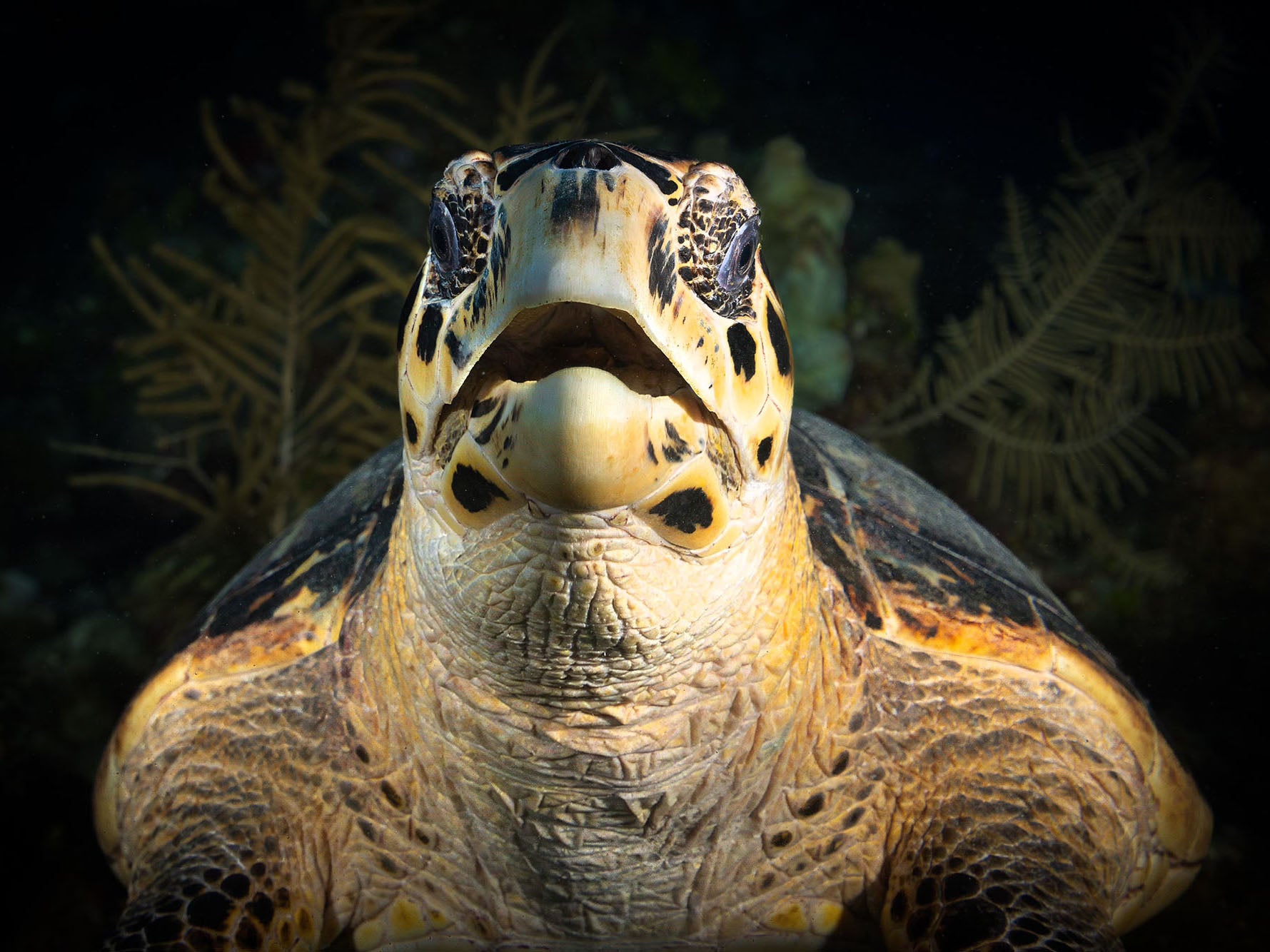Photos © Gary Burns
There are so many fascinating things to shoot underwater but few are as hypnotizing as a jellyfish floating by. We are excited every time we see them and totally absorbed by their beauty. Ambassador, friend, and dive buddy Gary Burns has mastered the art of the jellyfish photo and shares one of his favorite species: the egg-yolk jellyfish.
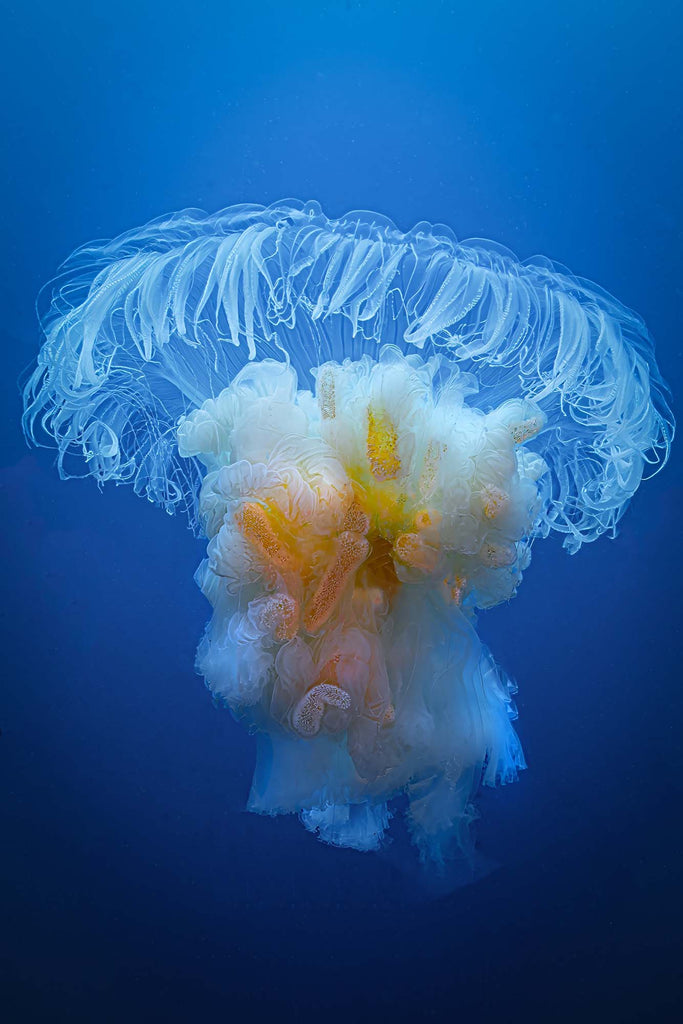
There’s an incredible amount of detail within the egg-yolk jellyfish from its bright yellow gonads to the delicate layers of tentacles. Photo © 2023 Gary Burns
The egg-yolk jellyfish (Phacellophora camtschatica) is common to the waters of the Northern Pacific Ocean. Gary often finds them when shooting in the Californias Channel Islands off the coast of Catalina. Gary finds them to be most predominant in the cooler spring time waters around the western coast of Catalina Island.
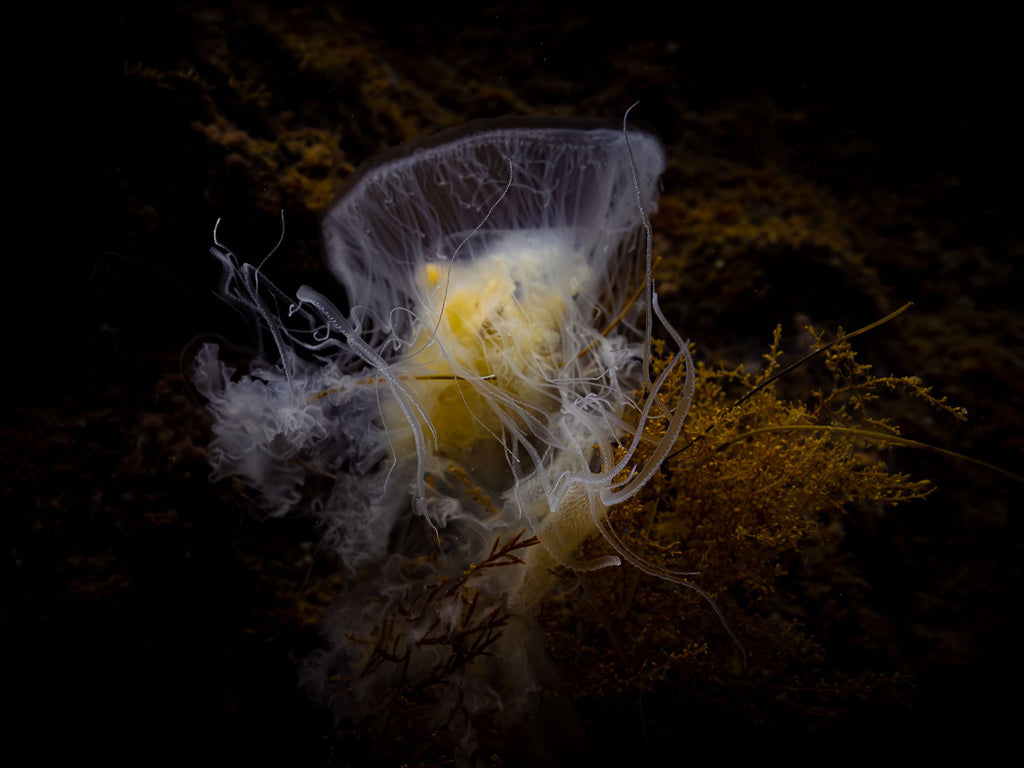
"In February they collect Pyrosomes from the ocean floor. Some of my earlier images show the Pyrosomes entangled in their tentacles."
They grow to about 1-2 feet in diameter (30-60 cm) and are commonly found drifting in the shallows. Their defining characteristic is their bright yellow gonads (don’t laugh) visible in the center of their bodies which clearly resembles the yolk of an egg.
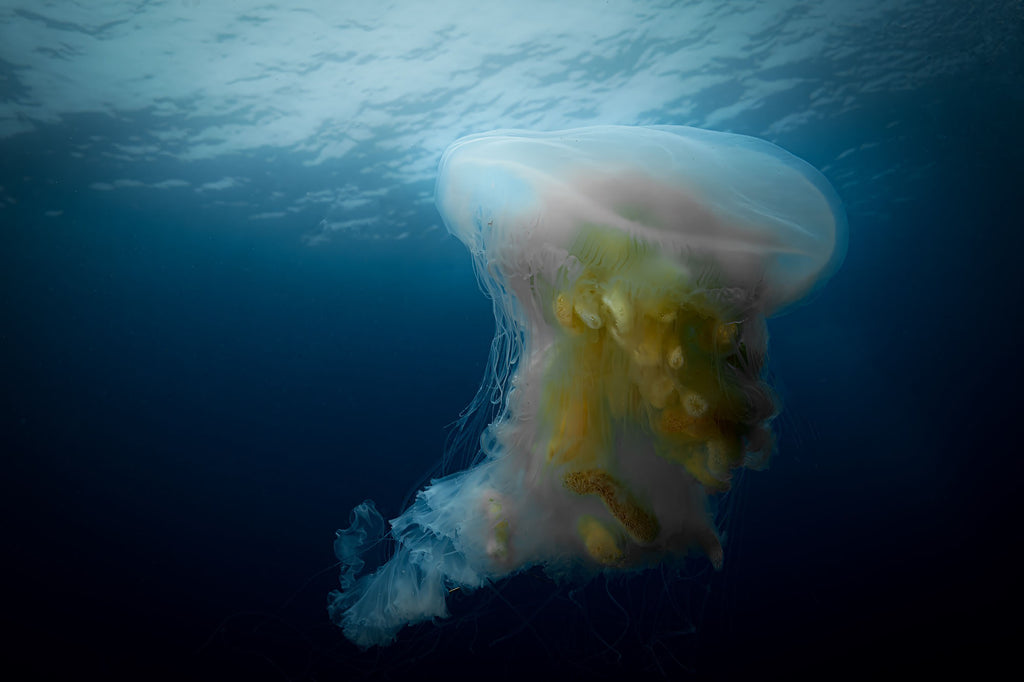
Shooting with only a single strobe can add depth and a more natural, directional look to your jellyfish photo as if it was lit by the sunlight coming through the water. Photo © 2023 Gary Burns
Shooting Techniques
It is challenging to take their photos as they are constantly in motion. Lighting conditions and focus are very important to consider. As you get closer to the surface, the natural light implies to step down your lens and move your strobe slightly wider to allow the sunlight to penetrate through the water to highlife the animal.
"The are captivating animals to watch and will move up and down in the water column. In mid water, they spread their tentacles out to the full and perform this magical dance. As they approach the ocean floor, they almost curl up and compress their bodies. I have seen them actually invert their tentacles upwards."
Shoot towards the kelp for perspective, or away from the kelp for bold contrasting water. Narrow your aperture to shoot “day for night” and highlight the jellyfish against a stark black background. Dark background images are typically shot at f/16 to f/22. You'll need powerful strobes to get the jellyfish exposed properly at these smaller apertures.

Jellies have no brain and their bodies are more than 95% water. They can detect light through sensors around the edge of their bodies or "bells."
The transparent jelly body gives you x-ray vision into its inner workings. The body and tentacles are layered like a couture gown. In some positions it’s almost like you’re observing a nebula in outer space.
Always be aware of your buoyancy near the surface as the jelly fish motion draws you up, always continue a normal breathing process. The jellyfish will actually come close to you as if it wants to chase you, they are very inquisitive
It’s best to go in the water with a strategy of how to shoot your intended subject. Check out our Jellyfish Camera Settings and Technique cheat sheet to increase your chances of great results out of the gate.
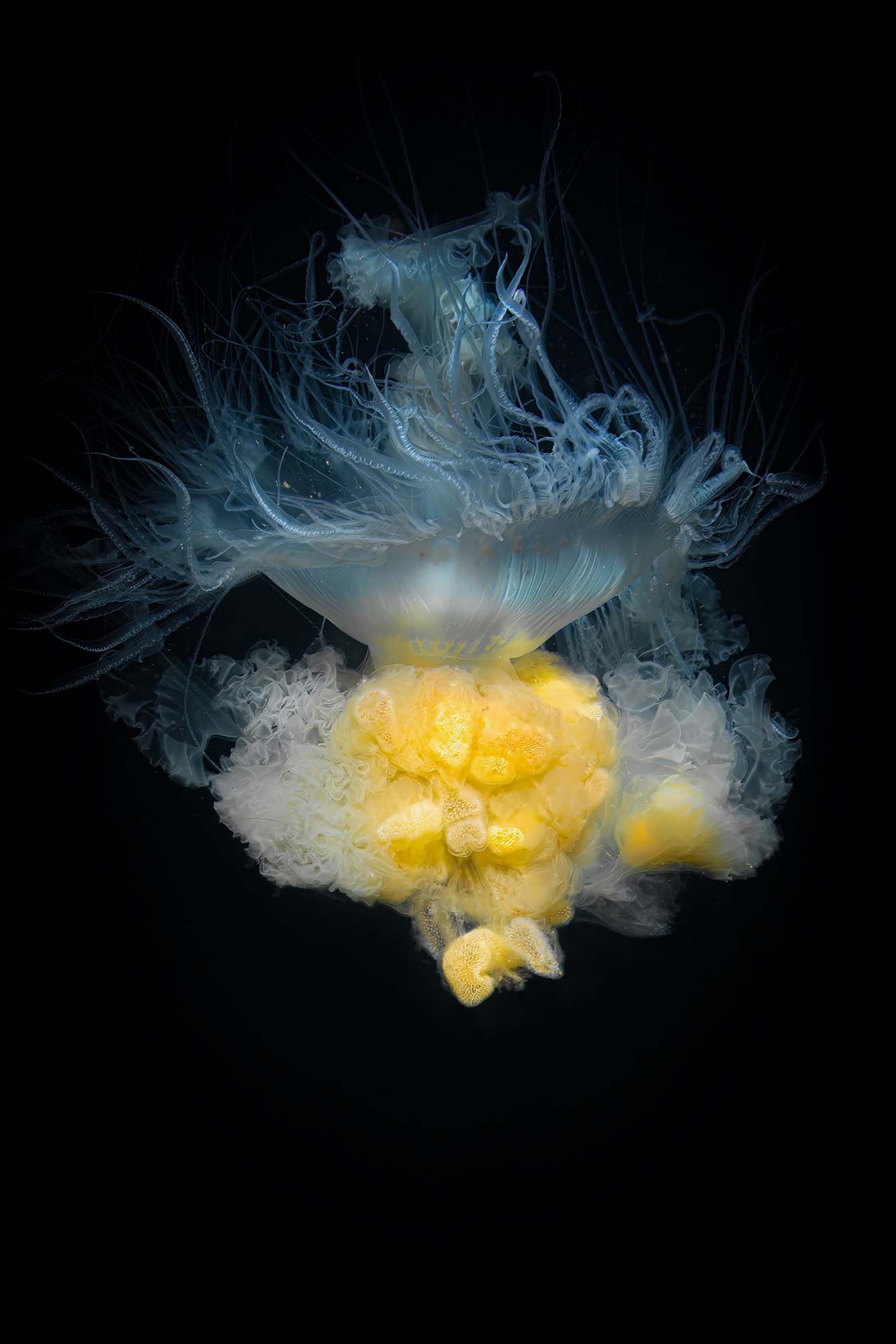
An inverted jelly looks ike it’s in free fall through space. Shoot powerful strobes that allow you to stop way down for a clean black background. Photo © 2023 Gary Burns
The Right Lens
A wide able lens with close focus capabilities is critical. The tentacles can spread up to 20 feet (6 m) long. Yet you need to be within 2-4 feet (about 1 m) to capture a crisp image of this intricate creature. Beyond that distance, the volume of water between you and the subject will soften the features significantly. Gary favors his RF 14-35mm f/4L IS USM lens on his Canon R5 when shooting the egg-yolk jelly.

A jellyfish enmeshed in its environment adds drama and almost looks like a queen sitting on her throne. Photo © 2023 Gary Burns
Bringing Out Detail
Apertures of f/8 and smaller will give you the depth of field you need for all of the jellyfish to be in sharp focus. Try using an AI-powered sharpening software like Topaz to reduce noise and, increase sharpness, and bring out all of the fine details in these celestial bodies.
Don't be discouraged if you capture some "backscatter" - floating particulate that looks like snow - when shooting open water photos. With the rapidly advancing AI cloning and fill tools, you can usually clean it up pretty quickly. Remember to always shoot RAW files so that you have maximum flexibility to adjust color balance, exposure, and clarity.

The longer spiny tubular things tangled up in the tentacles are caled Pyrazones. The jellies pick them up from the ocean floor. You won’t want a macro lens when you run across an egg-yolk jellyfish. They can grow up to 2 feet across with a substantial amount of bulk. Photo © 2023 Gary Burns
Other Jellyfish Opportunities
The egg-yolk jellyfish isn’t the only variety you can out there. There are over 2,000 varieties of jellyfish in the world’s oceans. If you want a guaranteed jellyfish sighting, you may check out Jellyfish Lake in Palau or the jellyfish sanctuary of Tojoman Lagoon, Philippines.
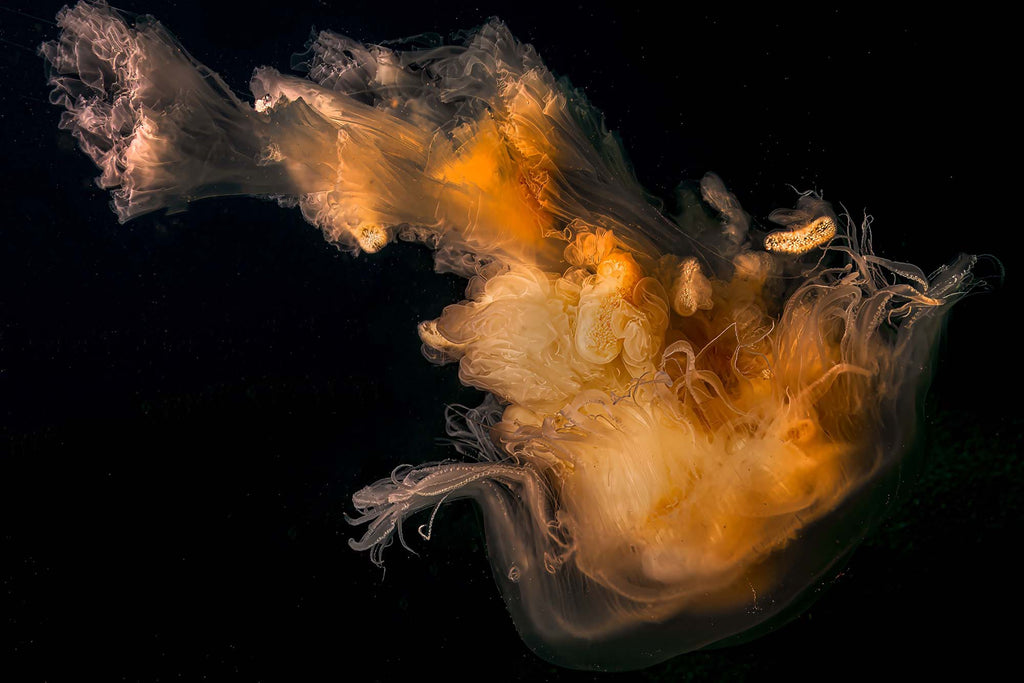
Don’t be afraid to color grade your photo for a unique feeling. Here the warmer tones give the jellyfish photo a kind of vintage appeal. Photo © 2023 Gary Burns
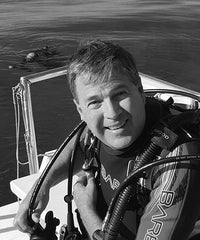 Ambassador Gary Burns is a Photographer and Aerospace Engineer. His work has taken him from his homeland of the UK to Canada to work with a leading aerospace team developing the first Challenger corporate aircraft. Gary now works out of Southern California where he dives on a regular basis in the Channel Islands off Santa Barabara and Catalina. During each adventure, the Ikelite underwater camera systems have been the perfect dive buddy. Read more...
Ambassador Gary Burns is a Photographer and Aerospace Engineer. His work has taken him from his homeland of the UK to Canada to work with a leading aerospace team developing the first Challenger corporate aircraft. Gary now works out of Southern California where he dives on a regular basis in the Channel Islands off Santa Barabara and Catalina. During each adventure, the Ikelite underwater camera systems have been the perfect dive buddy. Read more...
Additional Reading
Jellyfish Underwater Photography Camera Settings and Technique
Canon RF 14-35mm f/4L Lens Underwater Review [VIDEO]
Worth The Upgrade | Canon EOS R5 and R6 Full Frame Mirrorless Underwater [VIDEO]
Was it Worth Is? Gary Burns on Upgrading to the Canon R5 [VIDEO]
Diving Catalina Island with the Canon R5 and R6 [VIDEO]
Creature Feature: the Flashing Disco Clam
Underwater Cathedrals: Shooting Magnificent Kelp Forests
The Biggest and Smallest Creatures in Dauin, Philippines
Customer Photos | Douglas Klug in California's Kelp Forests and Beyond











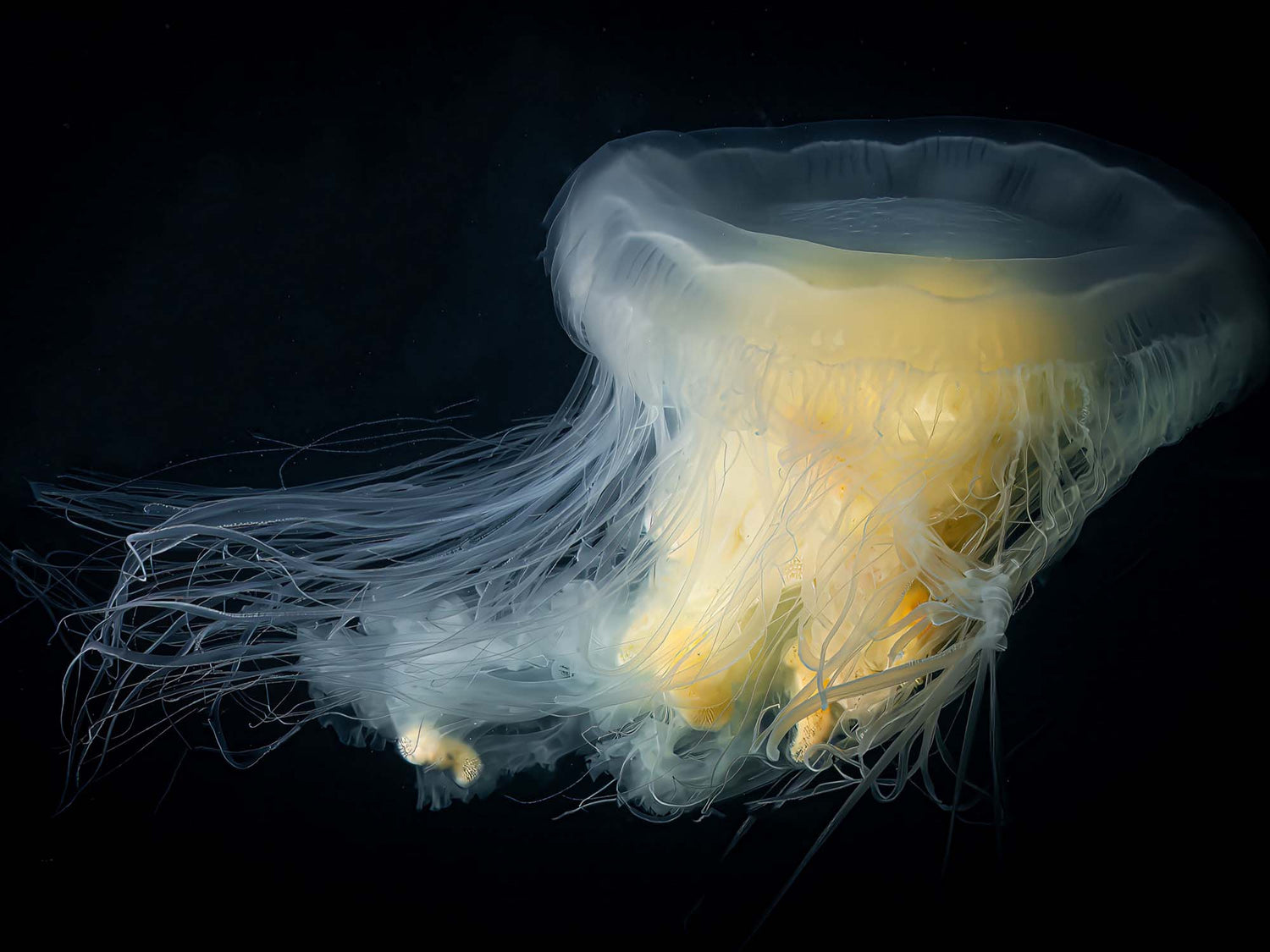

![Fluorescence Photography to Enhance Your Night Dive [VIDEO]](http://www.ikelite.com/cdn/shop/articles/ikelite-florescent-photography-blog-cover.jpg?v=1698967998&width=1800)
